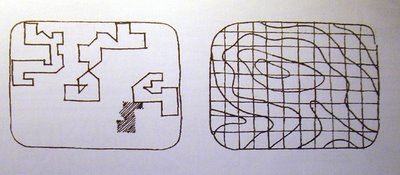
During this first meeting we intervied him.
A quite long interview...
After a phone call, we meet Mr. Friedman in his home. Everywhere there are wonderful things: sketches, drawings, books, rugs, philosophical opinions on the universe, wood blocks to make movies, toys from India.
The first simple truth: "We cannot understand the universe"
The second simple truth: "We do not need to understand the universe"
The chat oscillates from English to French with lapses into Italian. Mr. Friedman's assistant sits quietly on the rug.

----
Q. Mr. Friedman, there are some projects and ideas of yours that everybody knows: the flexible city that could be built in the sky and your passion for all kind of structures, grids and processes.
This time, though, we would like to ask you about a very specific project of yours, the "Flatwriter"...
A. Well, in the late '60s, I was doing a project called the "Flatwriter". It was simply an adaptation of the IBM Selectric typewriter, you know the one that carries the characters in relief on a ball that looks like a golf ball...
Instead of letters, we have these very simple symbols, and you can type down a floor plan. Of course, you need a special keyboard as well. This was supposed to be presented at the Osaka world fair, then there was some hitch on the organization side and it did not go through.
Q. Reading from the original text we find: Thanks to a machine that I call the Flatwriter, each inhabitant of a city can imprint his personal preferences with respect to his apartment (flat) to be, using symbols which put in visual form the different elements of his decision so that the builder as well as his neighbours can understand what his choice is.
In other words this machine contains a reportoire of several million possible plans for apartments, knows how to work out instructions about the characteristic consequences of the way each future inhabitants will risk upsetting the other inhabitants...
A. Yes. Exactly. But I want to say that this same operation I can do with a computer, with a typewriter or simply using stamps. This kind of thing is still possible and it is a very useful tool for participatory designs, regardless of the specific technological support.

---
You can read the rest of the interview on: id-cast
No comments:
Post a Comment